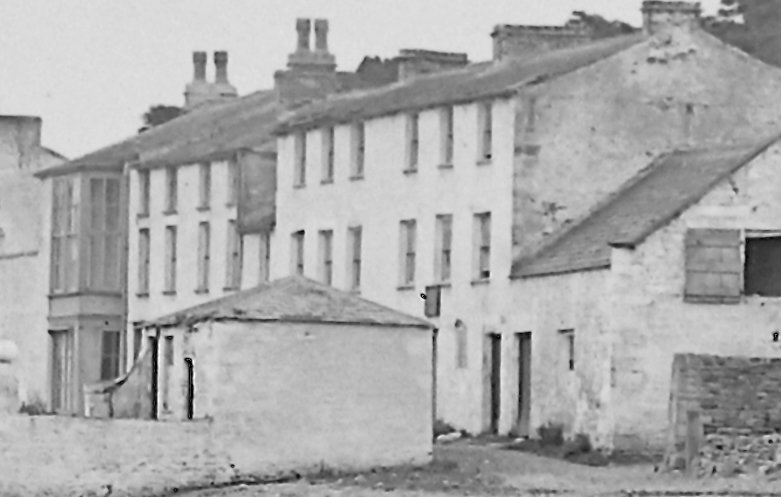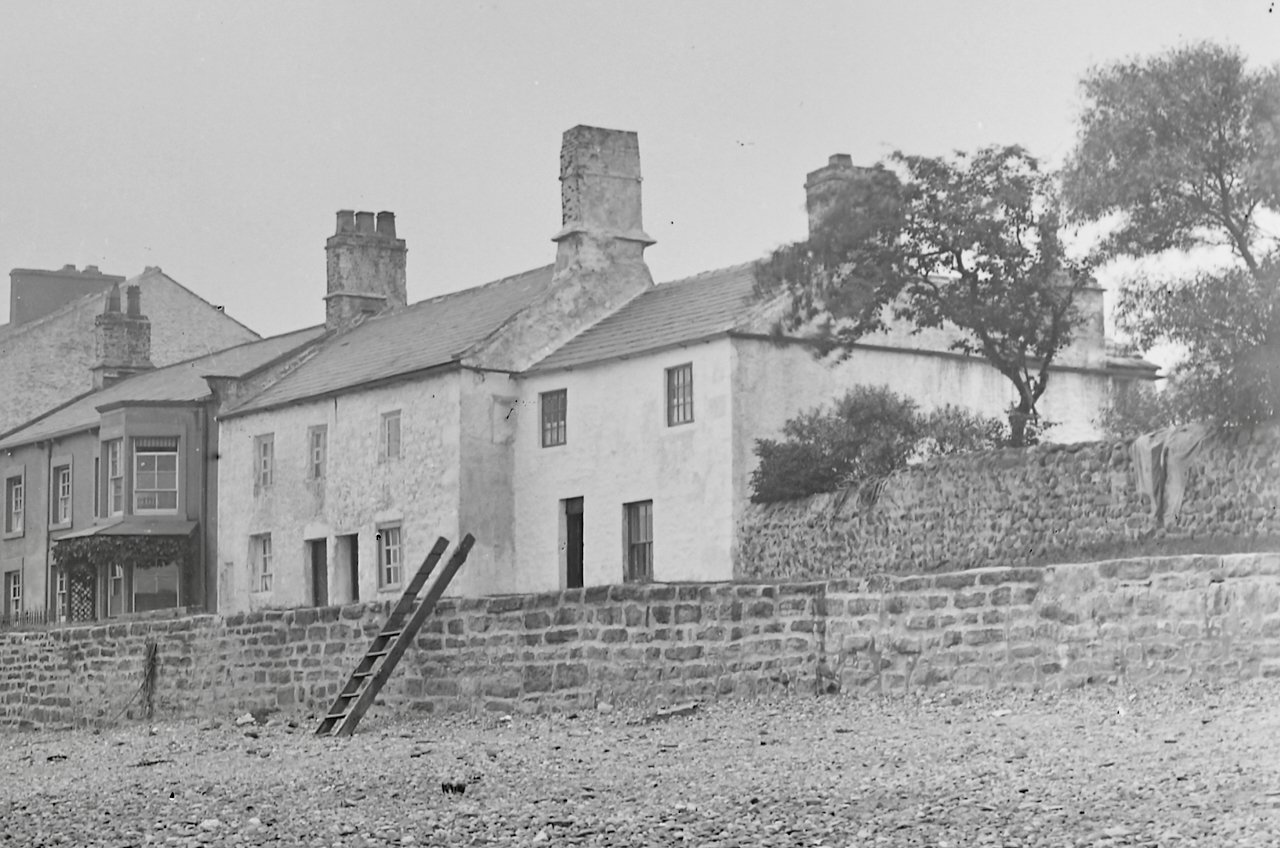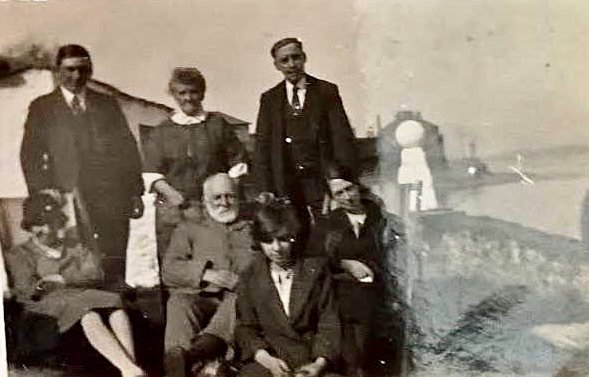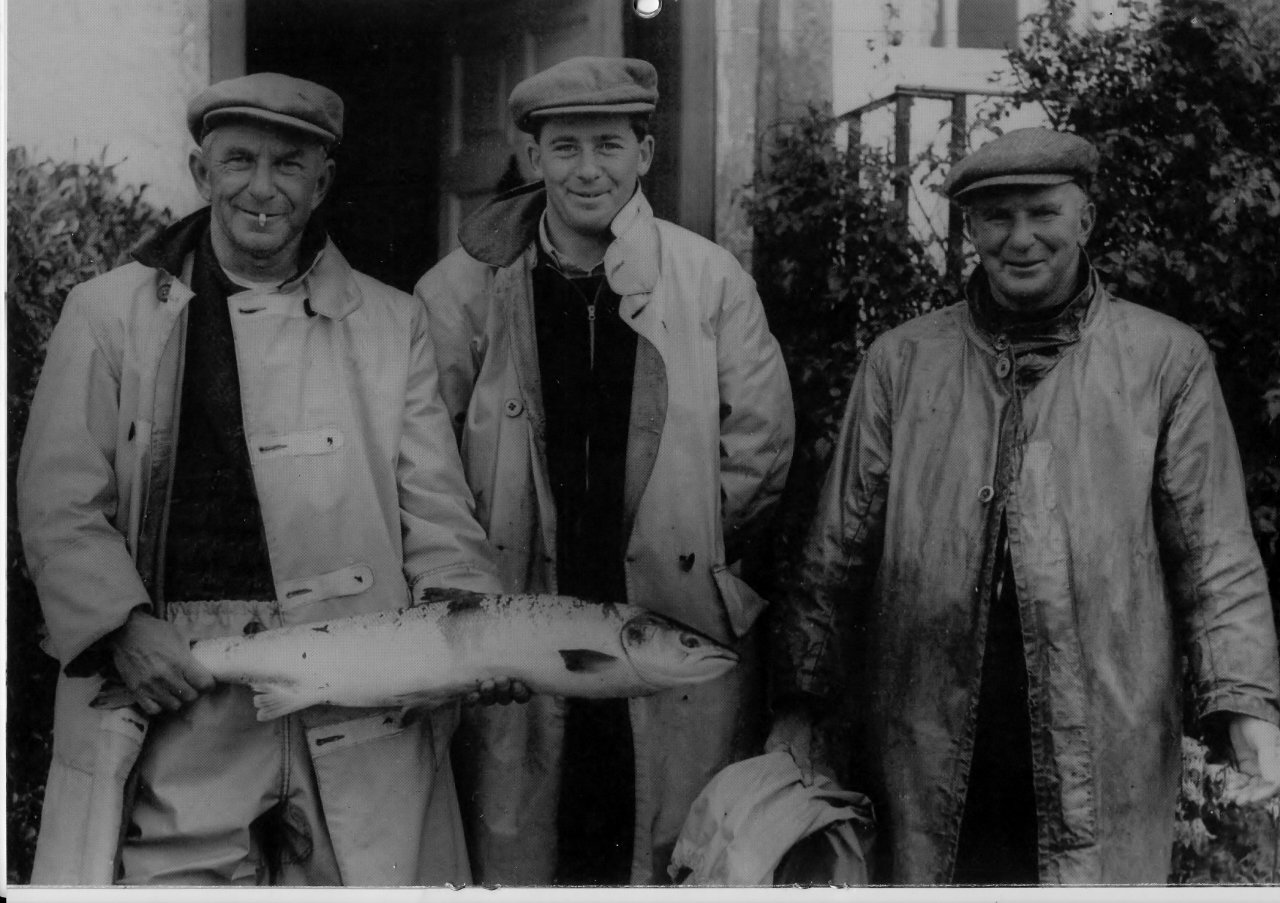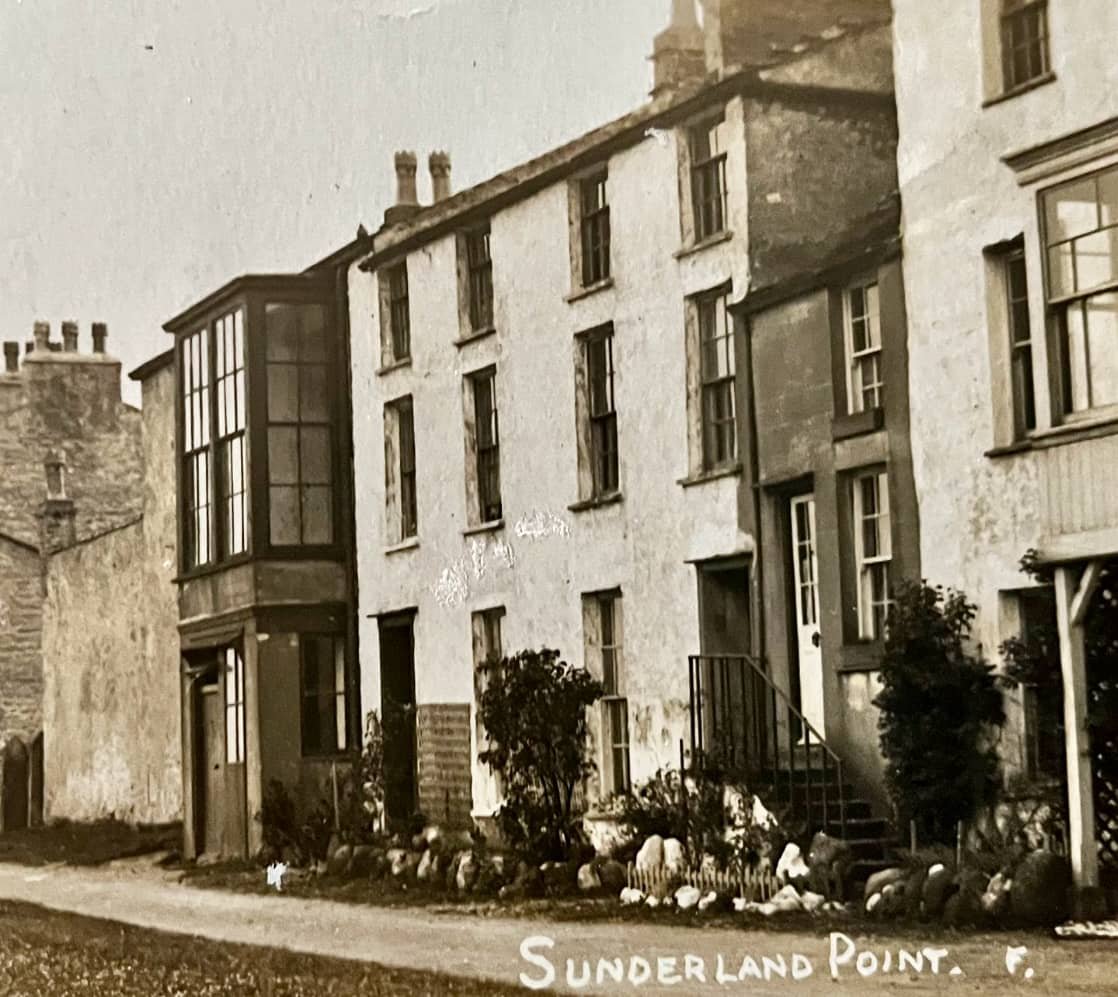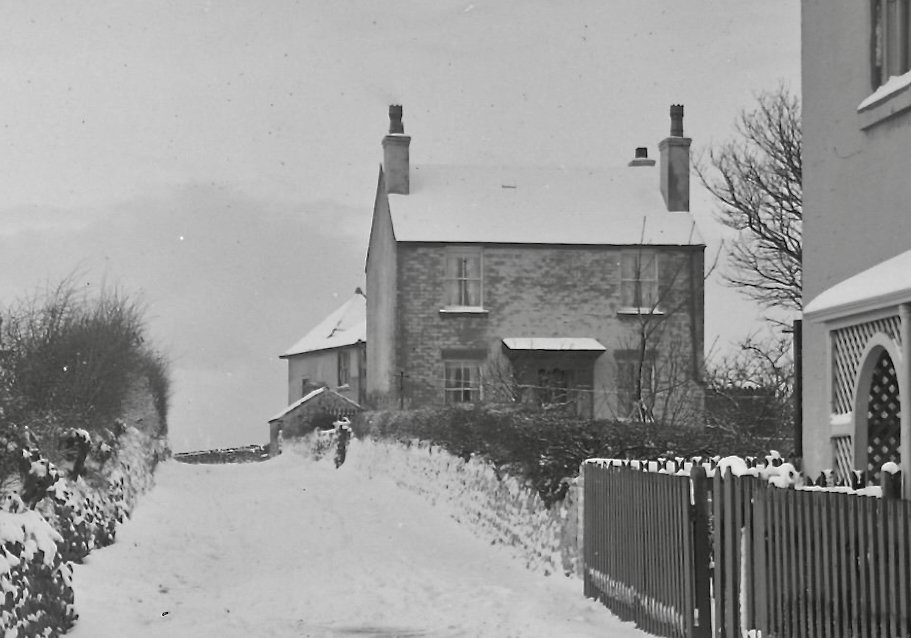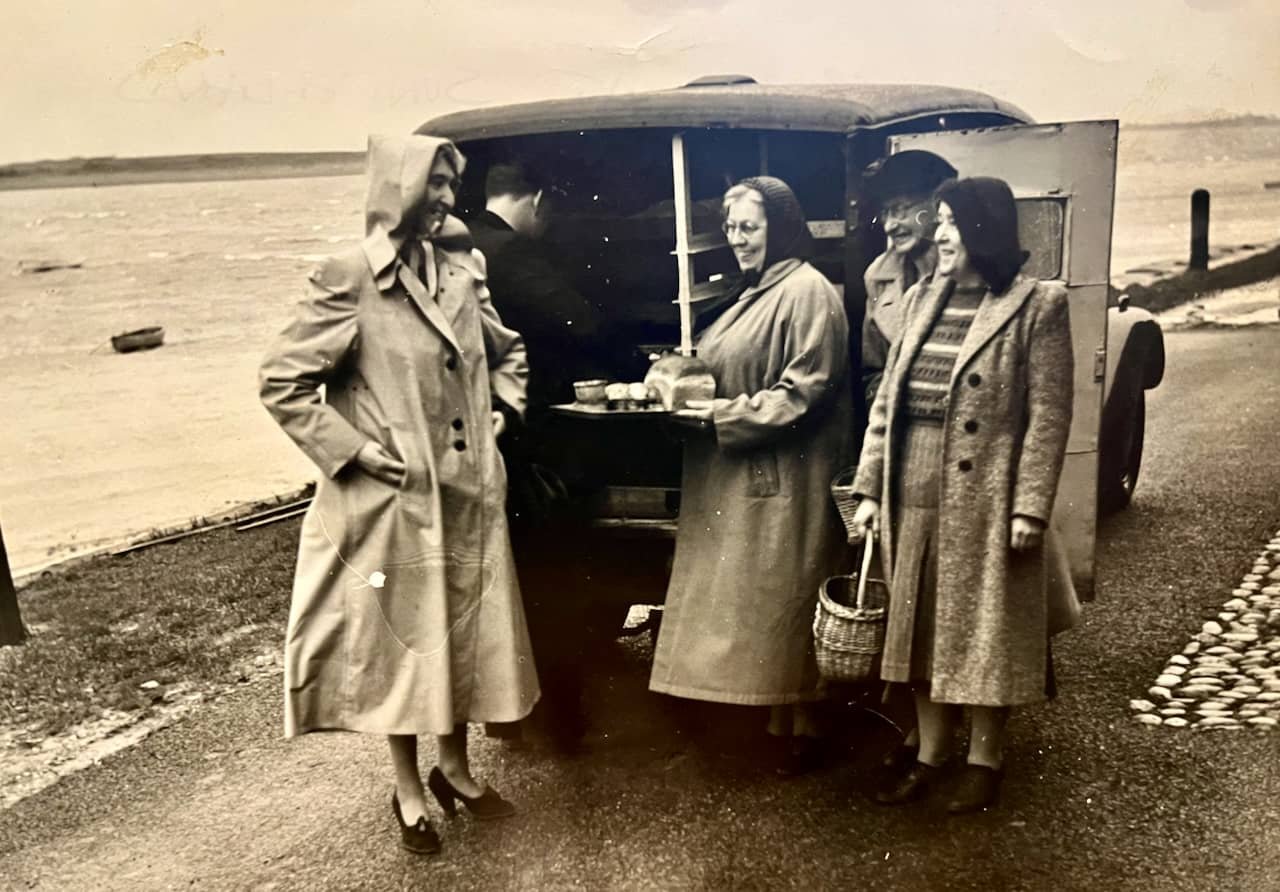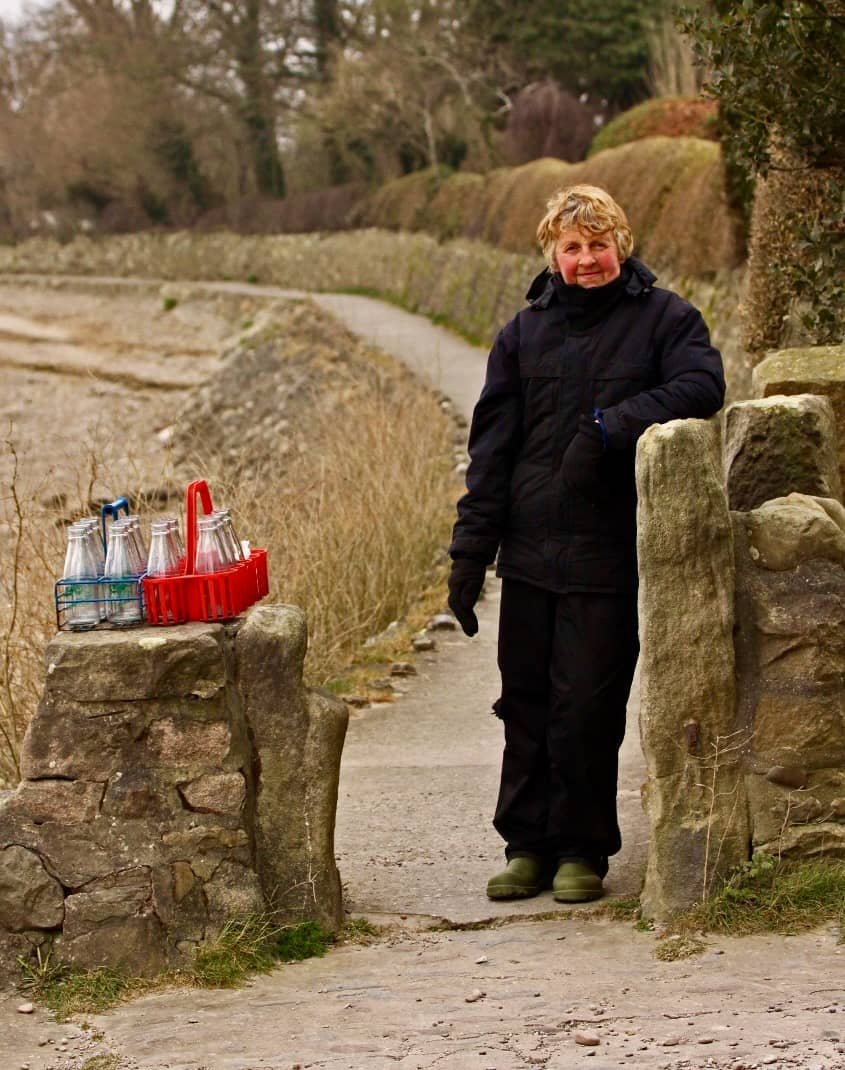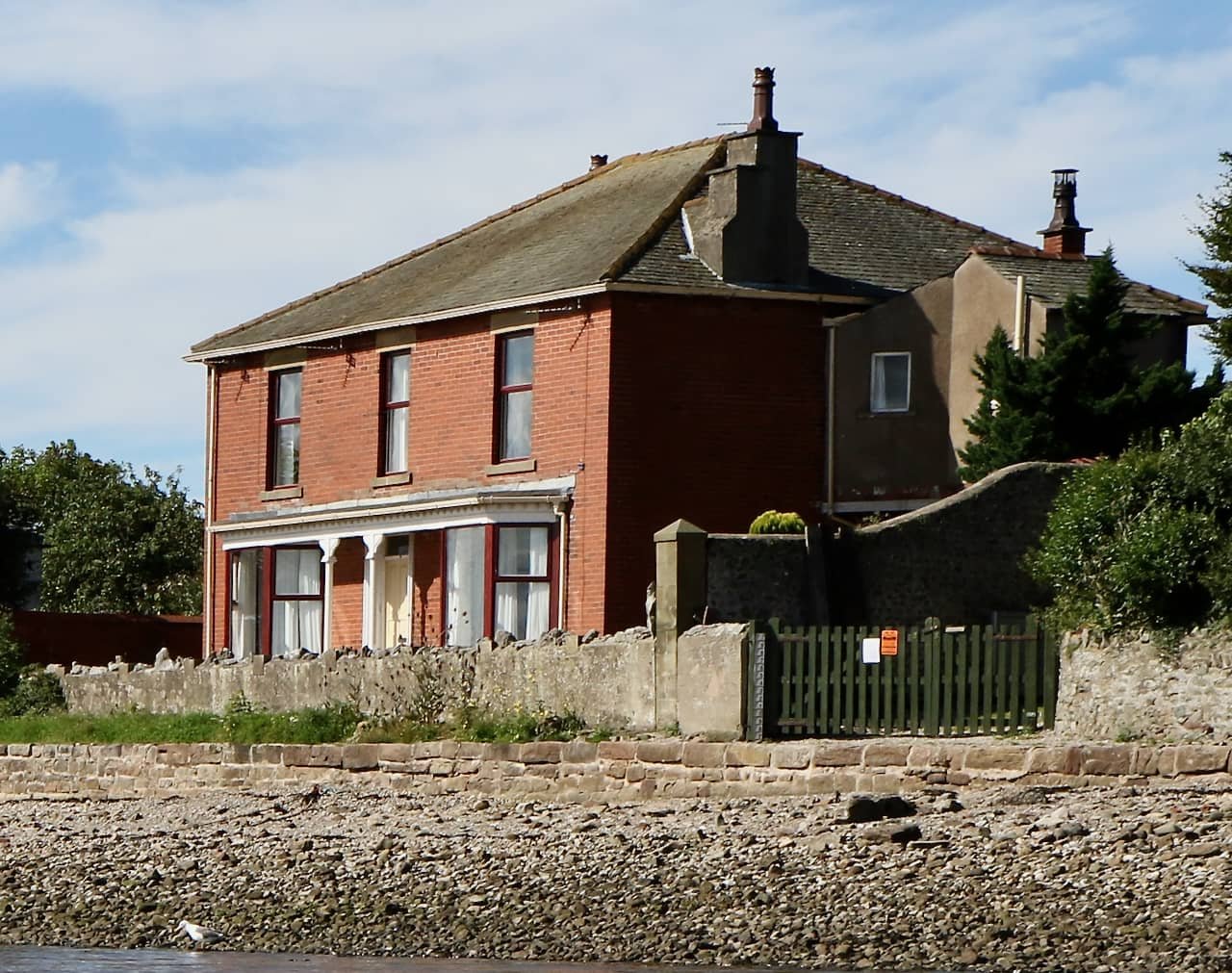The Village Shop
A sort of history with photos
The Post Office c1935. The man with the pipe is William Townley; opposite is his younger son, Arnold, with Bert Smith in the centre. The boy is unknown. A Sam Thompson photograph courtesy of Lancashire Archives.
It has been many years since there was a shop at Sunderland Point. Those in the past provided groceries, later a sub-post office, and more recently, provisions for visitors. Various mobile shops visited the village, and some residents sold homegrown produce and new-laid eggs; of these, Tom Smith is perhaps the best known.
Long before cars and fridges, almost all villagers grew vegetables, kept hens for eggs and meat, reared pigs, trapped rabbits, caught fish – codling, dabs (a kind of flatfish) and eels - and foraged for mushrooms and shot or netted wildfowl. Milk, cream and butter came from the farms, and most clothing was homemade.
Part-time residents coming for a summer stay would have needed a bit more, and visitors on a day trip looked for a cup of tea, a cake and ice cream.
This is our summary of ‘shops’. We will be delighted to hear from anyone who can expand or add to our list.
The Grocers Shop
Although largely self-sufficient, a grocer’s shop existed at the Point from the 1840s and probably long before that. What it actually sold is unknown, but our guess is tobacco and spirits, basic domestic items such as flour and yeast for baking, coffee, tea, sugar, dried fruits, and beans. The shop may have stocked other staples such as rice, soap, washing soda, candles, stove polish, and mousetraps. Oil for lamps and stoves would have been available.
*The 1841 census and 1844 tithe records have Barbara Gardner as a grocer, running a shop probably from where number 4 is today.
Number 4 is the first building on the right. A John Walker photograph c1900. Courtesy Lancaster City Museums.
Barbara, a widow, aged 50, was a tenant of Thomas Wilkinson, who also owned numbers 5 and 6. He may have run an earlier grocery shop, and when he moved to Overton, passed the business on to Barbara.
There could have been an indirect family connection - Barbara was born a Dickinson, as was Elizabeth ‘Betty’ Wilkinson, Thomas’s wife.
Barbara certainly had other family members nearby, lots of them. We can’t be sure, but it seems her father, Matthew, lived next door in number 5, a sister, Elizabeth, also known as Betty, lived up the Wynt at 7A, and another sister, Margaret, perhaps lived in number 10. Her brother, William ‘Barney’ Dickinson, had recently moved into Upsteps Cottage.
By 1851, Barbara had moved the shop to number 13 on Second Terrace.
Number 13 is the first house; a shop sign is above the front door. A John Walker photograph from c. 1890, courtesy Lancaster City Museums.
A grocer is not mentioned in the census of 1861, but it could have been fisherman Richard Gerrard, who was the village Grocer in 1871. Richard was also part of a large, long-standing SP family. His father, John Gerrard, was a pilot and fisherman who lived to the great age of 102, probably living at Cotton Tree Cottage (number 20). Richard’s older brother, also John Gerrard, was the innkeeper of Gerrard’s Hotel (Number 14) during the 1820s. Another brother, Ralph, was innkeeper at the Ship Inn for a short time in the 1840s. Later we see Richard’s son John living at number 6.
The shop seems to have moved back to number 4. We think this is because Richard bought numbers 4, 5, and 6 from Betty Wilkinson in 1857.
Another great John Walker photograph, number 4 to the right: Courtesy Lancaster City Museums
James W. Gardner (JWG), in his recollections on the houses and occupants, remembers it being: ‘Owned by Richard Gerrard, it was a shop until 1885 and had bow windows with pop bottle panes.’
In later years, Richard was helped by his granddaughter, Millicent Gerrard. Millie Gerrard married Richard Bagot, another fisherman and pilot. Here, she is in a much later photograph with her son Gerrard and his wife Edith. They are in the garden of number 4, the red brick number 3 in the background.
Millie Gerrard and family 1931: From the collection of Rosemary Lawn
This is a more recent photo of number 4
Number 4 a couple of years ago well stocked with memorabilia: Website collection.
In 1885, the shop returned to number 13.
Next door (at 14), what was once Gerrard’s Hotel and later the Maxwell Arms, had become Point Farm, still taking in lodgers, and under the tenancy of William Hodgson. He re-opened the grocers at 13. As we can see, looking closely at this familiar photograph, he chose to place his name above the door – though it was actually run by his wife, Ann.
Perhaps the ‘Band of Hope’ passing number 13, the sign says, ‘William Hodgson Grocer’ and lists items he is able to sell c1895: From the collection of Alan Smith.
JWG wrote, ‘Mrs Hodgson had the cottage as a toffee shop’ and had this anecdote:
‘Shirley Gardner once offered a penny to the one who could smoke most out of his old clay pipe. Of course, I would have a go but was soon sick and I didn’t want the penny then. The other lads spent the penny, buying cough drops at Mrs. Hodgson's.’
William fell into hot water when he attempted to recover the lost alcohol license. It failed miserably, and they were forced to leave the village in 1897.
The Bowkers, who followed, may have continued, but it appears to have lapsed as William Wells, the artist, lodged here during the summers in the early 1900s.
It notably reappeared in the 1920s with the arrival of Mrs Bertha Cuthill.
Mrs Cuthill’s Shop
Left to right: William Townley, Mr Needham, the postman and Mrs Cuthill, c1935. A Sam Thompson photo courtesy Lancashire Archives.
This is the best-known photograph of a shop at Sunderland Point. Alan included it in his 2015 calendar of older photographs. Notice it had also become a Post Office. This event hit the newspapers.
Morecambe Guardian 24th July 1931
FACILITY FOR SUNDERLAND POINT
Sunderland Point, the charming little village at the extreme end of the Morecambe and Heysham peninsular, is to have a Sub Post Office. This is the result of representation made by Mr Herwald Ramsbotham, M.P. on behalf of his constituents, to the Postmaster General;-
“You wrote to Mr Atlee on the 30th June regarding the inconvenience experienced at Sunderland Point under the revised postal arrangements by residents wishing to post parcels or bulky letter packets.” I have looked into the matter and you will be pleased to learn that, in view of the isolated position of the village, authority has been given to open a Sub Post Office there. This will meet the difficulty to which you refer. –
Here she is again, with Arnold and William Townley
Mrs Cuthill with stepson Arnold Townley and William Townley. A Sam Thompson photograph courtesy Lancashire Archives
Bertha Agnes Bradley was a widow when she first arrived at the Point. She became Mrs Cuthill after meeting James Cuthill, the father of Jessie Townley, who had married Arnold.
Here she is - one last time - in a recently discovered photograph
In front of the Bath House on Second Terrace. Mrs Cuthill is in the centre of the back row, and white-bearded Jack Cuthill is seated in the centre c1926. : Photo found by Ann Hatton and is the property of Susan Walker
It has been mischievously suggested that Jack’s marriage to Bertha contributed to his early death in 1927.
Here is a modern photo of number 13.
Number 13 Second Terrace: Website Collection
Towards the end of the 1930s, Mrs Cuthill became seriously ill and had to leave the Point. The fishermen brothers, Hubert and Arnold Townley, kept the business, dividing it between them.
Arnold (left) and Hubert Townley (right) with Tom Gardner in front of number 16: Collection Alan Smith.
Arnold Townley’s Shop
Arnold and Jessie sold cigarettes and sweeter stuff from their home at number 16.(Lodgers, including the writer’s parents, were taken during the season.)
During the war, it became popular with the soldiers at the camp. Iris Birks, the daughter of Arnold and Jessie, recalls that the shop sold sweets and ‘pop’ during the summer to visitors and later began offering tea and coffee to servicemen. Iris also remembers her father travelling to Overton to collect a tray of specially made small cakes to sell in the shop.
In her recent article, Rosemary Thacker remembered:
I was given coins to buy Smith’s crisps (with the salt bag) and dandelion and burdock from Townley’s front room (Number 16). Unknown to my parents, I once drank so much that we had a long and ultimately pointless trip to Lancaster hospital, thinking I had an appendicitis.
Number 16, next to the little house, Multum, as it was in the 1930s: From the collection of Hugh Cunliffe.
And as it is more recently.
Freshly painted numbers 15, 16 and 17 Second Terrace: Website collection.
In the 1960s, a similar shop was opened and run for several years by Mrs. Holmes from number 17. Her daughter, Irene Smith, lived at 16 and took in summer lodgers.
(JWG, in his summary of houses, remembers number 16 being a shop much earlier. This cottage also had many tenants….a Mrs. Gregory from Overton, she kept a shop there, this about 1897.)
Dorothy Calverley (née Townley) tells us that her aunt, Phoebe Townley, sold sweets from number 5.
For three or four years at the end of the 1960s, Mary Smith ran a hugely successful café in the large living room at number 3, with teas and coffee and sublime home baking.
The Post Office
Arnold Townley’s older brother Hubert and wife Clara took the sub–Post Office to their home, number 4 in the Lane. It continued in their name until the end of the 1950s when Hubert retired from fishing and moved to number 6 on First Terrace.
Clara and Hubert Townley at the Post Office, number 4 the Lane. Alan tells us the dog’s name was Bruce: A Peter Hall photograph.
Number 4, the Lane, in the early 1900s. A John Walker photograph: Courtesy Lancaster City Museums.
Number 4 this week: photo Rachael Knowles
Alan Smith remembers as a youngster going to Townley’s post office just after the war: “I went up there with a ration card and a few pennies to buy a quarter pound of of barley sugars”.
In the early 1960s, Margaret Smith, the wife of Philip Smith (senior), served as the sub-postmistress and was among the youngest ever to hold this position. Margaret also sold confectionery and ran a small café in the garden for a time.
Wedding photo of Margaret and Philip Smith in 1960: Collection Philip Smith.
The post office ended in the mid-70s when Margaret and Philip moved to number 14, needing more space for an expanding family.
Mobile shops
During the interwar years:‘almost every need was supplied by various tradesmen and one need not leave the place for weeks if one did not want to’ wrote Hugh Cunliffe.
In ‘for sale’ or ‘to let’ notices of houses in the post war years, they often said, ‘The village is well served by frequent visits of mobile shops’.
Indeed it was. The weekly visits of the coop butchers are within recent memory. Before that, Hugh remembers, ‘meat came from the Geldarts of Morecambe. Jack Geldart came every week, always jolly looking and smiling. some of the jollity was the result of a visit to the Globe in Overton before crossing the road’.
Hugh also remembers: ‘A Miss Burrow came on her bicycle from Overton every week. A large basket in front with homemade and other cakes. As she came up the cottage steps, she removed the spotless white cloth to reveal the exciting contents’
A regular tradesman arrived on some days with fish and on others with ice cream.
Throughout the 1950s, Mr Palin, the grocer in Overton, came once or twice a week. Competition arrived with regular visits of a large Coop grocery van, but that ended when it slid from the road and was completely submerged in a high tide. The van was a write-off and most of the stock was lost.
After this, twice-weekly deliveries of groceries were made by the Burns family, who ran the SPAR shop in Overton.
Mr. Dugdale the Butcher and his cart c1910s: courtesy of the Gilchrist family
And this is Mr. Baron’s bakery and grocery van, half a century later.
Mr Baron’s van 1960s, from the left Mrs D Gent, probably Mr Baron, an unknown friend of Mrs Gent, Mrs Denby and Mrs E Walker: Collection Hugh Cunliffe
By the late 1960s, the regular visits were becoming less frequent.
This sub-headline appeared in the Visitor in June 1968. The Burns family, after 15 years of delivering to the Point, decided to call it a day. While the tide receives much of the blame in the story, it was just as much the arrival of larger supermarkets and nearly universal car ownership among villagers that called time on the mobile shops.
Milk, butter, and cream
The local farms provided the dairy produce. Villagers needing milk would take their container to be filled at the farm. Bottled deliveries came later. Hugh Cunliffe described it in his book:
‘Before breakfast one of us would go to the Masons back door with a large jug. On the table near the door were two large earthenware bowls of milk and one of the daughters would take a metal measure and fill your jug, the milk would sometimes be still warm from the cow. The Masons made their own butter and I can remember the wooden butter pats which were used to make a pattern on top.’
Nellie (left) and Susie Mason, who sold milk, cream and butter from the back door of Temperance Hotel/Farm. Perhaps 1940s: From the collection of Alan Smith.
After the war, bottled milk was delivered from Hall Farm on Second Terrace and later from Sunderland Brows Farm. Margaret Hargreaves made the last delivery on April 13, 2013.
Margaret Hargreaves, who made the last milk delivery in 2013: Photo Alan Smith
Sale of local produce
Any surplus produce grown, caught or shot that couldn’t be sold was shared within families or swopped between neighbours. The grocer of the day may have sold some in the store.
Trevor and Margaret Owen sold eggs from the door while they were living in 7A.
Alan tells us this: Shortly after the war, Peter Hall, who was a very good gardener and lived at number 22 also had the use of the large garden at number 23. He sold the surplus stock around the village, transporting it in Robert Hall’s old pram.
So, back where we started with Tom Smith at number 3.
Tom first hung a chalk-written board on the gates in about 1957, not long after the family had moved in. Depending on the season, it advertised freshly caught salmon, whole or in steaks (sometimes gutted by Tom on the spot), shrimps, picked or unpicked, and whitebait. Also a wonderful array of fruit and vegetables which came from his gardens, along with fresh eggs from his many hens.
Number 3: Photo Alan Smith.
A salmon for the shop? Tom Smith at number 3: Photo Alan Smith
After more than 50 years, Tom finally took down the chalk-written board in 2012. He was 79.
We thank Kris Needham and Ann Hatton for their research, Dorothy Calverley and Alan Smith for their memories, and Tom and Philip Smith for checking the dates. Also to the many who allowed use of personal photographs.
*It’s not possible to be certain where these villagers lived, but these are well-researched suppositions.
A copy of ‘The story of Sunderland Point’ by Hugh Cunliffe is available from Lynne Levey at number 14 for £7. Lynne can be reached by e-mail at lynne.levey@icloud.com


